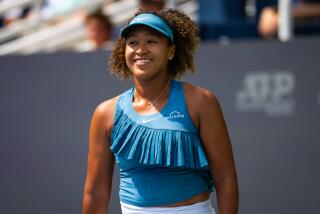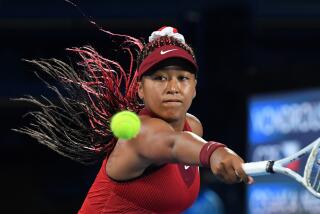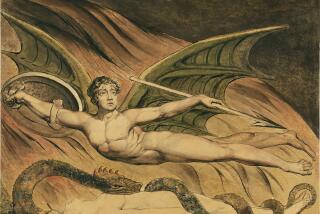Fighting his way back
- Share via
LAST week in Los Angeles was almost perfect for James Blake. Yes, he lost in the finals of the Countrywide Classic at UCLA, but on the plus side, the 27-year-old professional tennis player, currently ranked No. 10 in the world, saw his new memoir, “Breaking Back: How I Lost Everything and Won Back My Life,” hit the bestseller lists. The book recounts his comeback from a nightmare episode in 2004 when, in despairing succession, Blake broke his neck in a freak accident while practicing in Rome, lost his father to cancer, and was struck by a debilitating virus that threatened his career.
“This is the story on my relationship with life, and how I got through those dark days, arriving on the other side with a new understanding, and new approach to everything I do,” he writes in a self-revealing tone that has become his post-traumatic trademark. Blake said he sat down at the computer and did much of the writing, then worked with coauthor Andrew Friedman to polish the manuscript.
The result is a rarity among sports autobiographies: an emotionally forthcoming page-turner. Then again, Blake is a rare pro athlete: a recovering East Coast neurotic in a suntanned, narcissistic profession that has a low tolerance for psychological stumbles. Unlike John McEnroe, an equally neurotic New York-bred player who dominated tennis as a rage-junkie in the 1980s, Blake has turned his struggles into the athletic equivalent of psychotherapy, amply evidenced in the book. While McEnroe, decades after retiring, has turned his torment into a profitable shtick, Blake has achieved a productive, courtly equilibrium -- a kind of self-effacing selfishness -- that has become a competitive asset. “When I’m at a tournament, I’m selfish,” he said, “But I don’t want it to become a habit.”
To look at Blake, the best male tennis player of African American heritage since Arthur Ashe, you wouldn’t know that he’d been through such a personal hell. His general appearance is luminous. Off court at the tournament, he wore stylishly shredded jeans, a snug Nike shirt (the Empire of Swoosh has clothed Blake since he turned pro in 1999) and black low-cut Converse Chuck Taylors. His shaved head was capped by the logo of the New York Mets, the Yonkers native’s favorite team. The eyes were bright, the voice confident and unwavering, the smile glowing and effortless.
Blake is, to put it mildly, an impressive individual, even if he describes himself as a “dumb jock college dropout.” Of course, the college he dropped out of was Harvard, and he did so to begin collecting serious prize money and lucrative endorsements.
For a time in 2004, it looked as if that was all going to be taken away. The broken neck had healed, but that injury and the death of his father, combined with a nagging sense that he wasn’t living up to his tennis expectations, led to a case of zoster, an ailment brought on by the virus that causes shingles and chicken pox.
“There was never any guarantee that he would recover,” said his older brother, Thomas, also a pro player. Generally feared on the ATP Tour for his lethal forehand and blazing speed, the stressed-out, zoster-afflicted Blake was dizzy, disoriented and barely capable of rallying with his longtime coach, Brian Barker, much less facing down Roger Federer or Rafael Nadal. Before zoster struck, Blake had been a model and was named People’s “Sexiest Male Athlete” in 2002. Now, his face sagged on the left side and his vision was iffy.
He had plenty of reasons to freak out, but instead he decided to embrace his Job-like physical ordeal. “I started to believe that everything happens for a reason,” he said. Separating himself from the “traveling neverland” of pro tennis, he found refuge in his friends and family.
Blake said the impetus for writing the book began during his illness, when he was considering, as he put it, “other possibilities.”
Originally, he envisioned a children’s book, but as he recovered, publishers began to show an interest in the story of his tribulations. Assisted by a book agent at International Creative Management, he connected with HarperCollins, which took on the project. In the book he visited unfamiliar territory for notoriously self-absorbed professional athletes: his emotional landscape. “I tend to internalize a lot of things,” he said. “It’s new for me to have my emotions out there, but it’s also been very therapeutic.”
It’s been good for his game. Prior to his annus horribilis, Blake, as he puts it in the book, “had begun to develop a reputation: a lot of fans, sportscasters, and journalists thought I had talent, but the prevailing feeling was that I didn’t want to win badly enough.” On his best surface, American hard courts, he had lost two tense matches to Australian Lleyton Hewitt at the U.S. Open. He seemed unable to raise his brash, shot-making, crowd-pleasing game to the next level. Commentators alleged that he was a sullen head-case when challenged, and that he was incapable of finding the emotional fortitude to break into the top 10. “In the past, stuff would linger with him,” Thomas Blake said. “For days, he would be a bad mood.”
Blake’s recovery period gave him an unexpected chance to reflect on his good fortune. When he returned to competition and realized his game wasn’t yet ready for prime time, he decided to reestablish his confidence via the sport’s bush leagues. He then undertook a run that saw him capture three titles in 2005, a year highlighted by an epic quarterfinal duel with Andre Agassi at the U.S. Open. Blake lost that match in five sets, but the meeting is now regarded as a classic. In 2006, he briefly displaced Andy Roddick as the top American player. He has an undefeated record against Nadal, and at last year’s Open, he took a set off eventual champion Federer in the quarterfinals.
With revived fame, however, has come perspective. “Pro athletes are supposed to keep their guard up,” he said. “But without my friends and family around when I was sick, everything would have been so dark. I made a huge leap in my maturation process. I learned that if you burden other people with your problems, it won’t make you a weak person.” The introvert who overcame scoliosis as a teenager had transformed himself into an extrovert, complete with his own traveling cheering section, the loyal “J Block.”
His new attitude was vividly on display during his second-round match last week, against journeyman pro Paul Goldstein. After wiping the court with his opponent 6-0 in the first set, Blake fell into a ragged patch of unforced errors, dropping the second set 1-6. Though he looked annoyed, he never looked discouraged, and in a barn-burner of a third set, he overcame a Goldstein match point and eventually won.
It was abundant evidence of his new lease on life. “I love getting up in the morning now and thinking about success,” he said.
There might be more writing to come. “If you can win one set, you can win two,” he maintains. It stands to reasons that if you write one book, you can write another. “I have two years to go at Harvard when I’m finished with tennis. I want to give myself a chance to get just as passionate about something else.”
More to Read
Go beyond the scoreboard
Get the latest on L.A.'s teams in the daily Sports Report newsletter.
You may occasionally receive promotional content from the Los Angeles Times.










